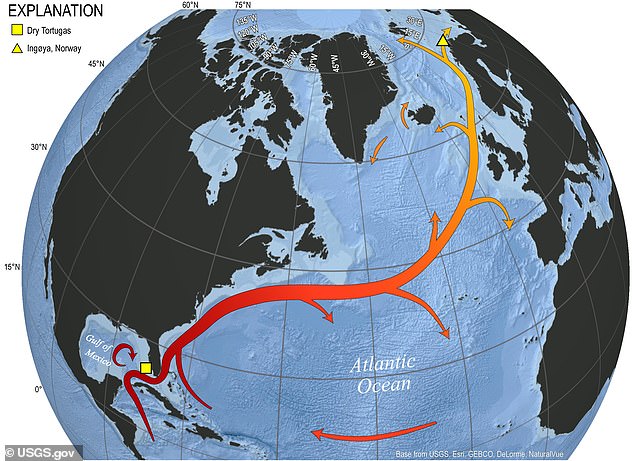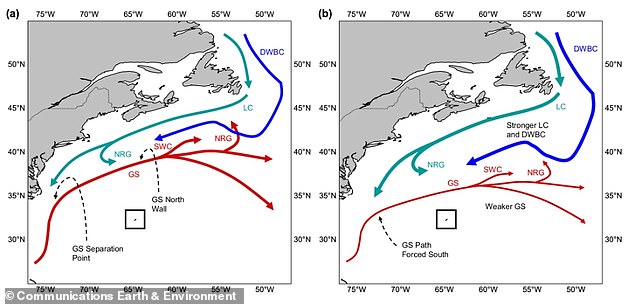By JONATHAN CHADWICK, ASSISTANT SCIENCE & TECHNOLOGY EDITOR
Published: | Updated:
The Gulf Stream has been getting weaker for much longer than we thought – and it could be on the verge of total collapse due to climate change.
According to British scientists, the Gulf Stream – which is part of a much wider global system of ocean currents – moved northwards 300 years ago.
This, they say, is a sign that it started slowing down then – before the Industrial Revolution and about 200 years earlier than previously believed.
And the ‘sensitive’ system could soon ‘cross a tipping point’ prior to its total collapse.
The Gulf Stream is a major ocean current that moves warm surface water from Mexico northward across the Atlantic towards Europe.
It’s one of the most important natural weather systems, keeping northern and western Europe warm.
When it collapses, it could plummet Europe into a deep freeze reminiscent of the Hollywood film ‘The Day After Tomorrow’.
In the 2004 movie, the Thames freezes over and the Houses of Parliament are smothered in a deep layer of snow.

The new study was led by Edward Forman at the University of Southampton and James Baldini at Durham University.
They explain that the Gulf Stream is only a small part of a much wider system of currents, officially called the Atlantic Meridional Overturning Circulation (AMOC), which is being weakened by climate change.
Described as ‘the conveyor belt of the ocean’, AMOC transports warm, salty water near the ocean’s surface northwards from the tropics up to the northern hemisphere.
This is crucial for keeping Europe, the UK, and the US east coast ‘temperate’ – meaning neither very hot nor very cold.
According to the team, when the AMOC weakens (slows down), the Gulf Stream moves northward, crossing the Atlantic at higher latitudes.
Their study found that their Gulf Stream moved northward 300 years ago – a sign that the AMOC started slowing down then.
If AMOC slows down too much, it could lead to dramatic regional climate change. Northern Europe would experience extreme cooling of up to 15°C, causing winter temperatures to plunge, overriding the warming driven by human activity.
Meanwhile, rainfall and weather patterns across the tropics and subtropics either side of the equator would move and intensify.


What is the AMOC?
The Gulf Stream is a small part of a much wider system of currents, officially called the Atlantic Meridional Overturning Circulation or AMOC.
Described as ‘the conveyor belt of the ocean’, it transports warm water near the ocean’s surface northwards – from the tropics to the northern hemisphere.
When the warm water reaches the North Atlantic (Europe and the UK, and the US east coast), it releases the heat and then freezes. As this ice forms, salt is left behind in the ocean water.
Due to the large amount of salt in the water, it becomes denser, sinks, and is carried southwards – back towards the tropics – in the depths below.
Eventually, the water gets pulled back up towards the surface and warms up in a process called upwelling, completing the cycle.
Scientists think AMOC brings enough warmth to the northern hemisphere that without it, large parts of Europe could enter a deep freeze.
Perhaps surprisingly, the team based their findings on stalagmites – the spectacular mineral formations that rise from the floor of caves. Stalagmites grow slowly as water drips down from the cave ceiling, gaining a millimetre every few years.
Over hundreds or perhaps even thousands of years, stalagmites record the chemical signals of the dripwater that formed them – revealing past climate patterns.
‘Cold weather tends to be windier, for example, leading to more sea spray and more seawater in the dripwater,’ the team explain in a piece for The Conversation.
‘Analysing the chemistry of one of these stalagmites has thus enabled us to indirectly reconstruct past sea surface temperatures.’
The team analysed stalagmites at Leamington Cave in northeastern Bermuda, which showed that after 1720, Bermudan sea surface temperatures cooled substantially for more than a century.
At the same time, records to the north along the east coast of North America show the opposite – warming where there had previously been cold temperatures – suggesting the Gulf Stream had shifted north.
Because the AMOC began weakening such a long time ago – in 1720 before the widescale release of fossil fuels from machinery during the Industrial Revolution – the AMOC may be more sensitive than we previously thought.
As countries around the world continue to burn fossil fuels in the 21st century, the AMOC may be ‘closer to a tipping point’ than ever.


‘If a tipping point is crossed, the weakening would become self-perpetuating and lead to a near-complete shutdown of these vital ocean currents,’ the team say.
‘As global temperatures pass 1.5°C over the next few years, many climate models predict further weakening of the AMOC – and potentially even a collapse this century.’
The study, published in the journal Communications Earth & Environment, shows that ‘even small changes in ocean circulation can have large regional consequences’.
‘A sustained movement of the Gulf Stream would lead to changing regional temperatures, rainfall patterns and more extreme weather,’ they conclude.
‘This could have serious implications for wildlife and food security, as ecosystems struggle to adapt to the changing climate.’
Is ‘The Day After Tomorrow’ an accurate portrayal of the future?
Paleoclimate records constructed from Greenland ice cores have revealed that AMOC circulation has, indeed, shut down in the past and caused regional climate change, according to the University of Illinois.
It caused the area around Greenland to cool by 44 degrees Fahrenheit.
In the 2004 film ‘The Day After Tomorrow,’ New York City’s temperature dramatically dropped to a point that a deep freeze appeared within a day.
Even a second outside and the movie’s characters would freeze to death.
Scientists say the film plays up the shift, which would take decades to see, but note temperatures would dramatically decrease along the eastern US coast.

Winters would become colder and storms more frequent that would linger longer throughout the year if the AMOC would come to a halt today.
However, scientist say it isn’t the cold temperatures that we should prepare for, it will be the rise in sea levels that will have the largest impact.
The increase would be caused by water piling up along the east coast that would have been pushed away by the northward surface flow.
But with AMOC weakened, or at a stop, experts say sea levels around the North Atlantic Basin could experience a rise up to nearly 20 inches.
This would eventually push people living along the coast from their homes and further inland to escape flooding.
A weakened AMOC would also decrease the amount of rainfalls in the North Atlantic that would cause intense droughts in areas that rarely experience such events.







